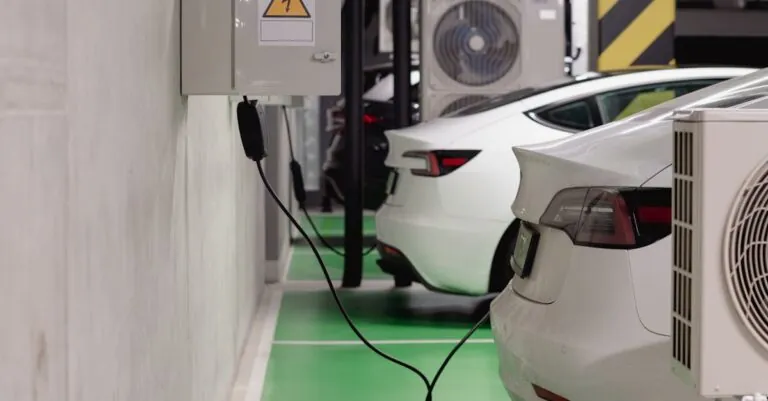Table of Contents
ToggleIn a world where electric vehicles are zooming past gas guzzlers, charge points are the unsung heroes of the road. Imagine a future where your car gets as excited about a charge point as you do about a coffee break. With more drivers making the switch to electric, these charging stations are popping up faster than you can say “Where’s my charging cable?”
Overview of Charge Points
Charge points play a crucial role in the electric vehicle ecosystem. These locations provide the energy needed to recharge electric vehicle batteries, enabling longer drives without range anxiety. Types of charge points include Level 1, Level 2, and DC fast charging stations, each offering varying recharge speeds.
Level 1 charge points, often found in residential homes, use standard 120-volt outlets and deliver approximately 4-5 miles of range per hour. Level 2 charge points, commonly located in public areas and workplaces, operate at 240 volts and can charge an electric vehicle up to 25 miles of range per hour.
DC fast charge points cater to drivers seeking quick recharges, supplying rapid power that can restore up to 80% of battery capacity in around 30 minutes. Charge points not only support electric vehicle owners but also contribute to decreased greenhouse gas emissions and improved air quality.
Statistics indicate the number of charge points is on the rise. A study from the Department of Energy notes that as of December 2022, there are roughly 140,000 public charging outlets in the United States, a significant increase from previous years. This growth aligns with projections that anticipate a further expansion in the coming years, driven by incentives and policies promoting electric vehicle adoption.
Adoption of smartphones and other technologies has led to the development of mobile apps designed to locate nearby charge points easily. These applications provide real-time availability, making the charging experience more convenient.
Investment in charge point infrastructure fosters a sense of community among electric vehicle users. Enhanced connectivity among charge points encourages more drivers to adopt electric vehicles, propelling a shift toward sustainable transportation solutions.
Types of Charge Points
Charge points come in various types, each serving specific needs for electric vehicle users. Understanding these types helps in choosing the right charging solution.
Level 1 Charge Points
Level 1 charge points primarily operate on a standard household outlet. With a typical output of 120 volts, they provide approximately 4-5 miles of range per hour. Many electric vehicle owners utilize this option at home, allowing for overnight charging while parked. This setup suits those with longer parking durations at work or home, effectively replenishing battery power without requiring additional infrastructure.
Level 2 Charge Points
Level 2 charge points significantly enhance charging speed compared to Level 1. Located in public areas and workplaces, these outlets deliver around 25 miles of range per hour, using 240 volts. Many commercial properties install Level 2 chargers to support employees or customers with electric vehicles. This option attracts users seeking a balance of speed and convenience, accommodating daily commutes or short stops.
DC Fast Charge Points
DC fast charge points represent the most advanced charging technology available. Charging at a rapid pace, these stations can restore up to 80% of an electric vehicle’s battery capacity in about 30 minutes. Positioned along highways or major travel routes, DC fast chargers meet the demands of long-distance drivers. As a result, they alleviate range anxiety, making road trips in electric vehicles more feasible.
Key Features of Charge Points
Charge points display various features that enhance the overall electric vehicle charging experience. These attributes focus on efficiency, convenience, and user interaction.
Charging Speed
Charging speed varies significantly across different charge points. Level 1 charge points offer about 4-5 miles of range per hour, making them more suited for overnight charging. In contrast, Level 2 charge points provide around 25 miles of range per hour, appealing to users seeking quicker solutions during their daily routines. DC fast chargers stand out as the fastest option, restoring up to 80% of battery capacity in approximately 30 minutes. This rapid recovery enables seamless long-distance travel without significant delays. Users appreciate the versatility of charge points, as they cater to a wide range of charging needs and preferences.
Connectivity Options
Connectivity options play a crucial role in the functionality of charge points. Most charge points offer both AC and DC charging options, ensuring compatibility with a broader range of electric vehicles. Many charge points now incorporate Wi-Fi and cellular connectivity for remote management and real-time data sharing. This connectivity facilitates convenient updates and monitoring of charge point status for operators. Mobile apps increasingly support Bluetooth connections, allowing users to unlock charge points and pay effortlessly through their smartphones. Such advancements enhance the user experience while seamlessly integrating charging infrastructure with digital technology.
User Interface
User interface design significantly impacts the user experience at charge points. Most charge points feature intuitive touchscreens that display essential information, including charging status, estimated charging time, and payment options. These screens guide users through the charging process with clear prompts, minimizing confusion. Many charge points now support multiple languages, ensuring accessibility for diverse users. Additionally, advanced interfaces sync with mobile apps, offering notifications for charging completion or status changes. User-friendly design contributes to a smoother and more efficient charging experience, encouraging broader adoption of electric vehicles.
Benefits of Using Charge Points
Charge points provide numerous advantages, enhancing the electric vehicle experience. They contribute positively to the environment and offer financial benefits for users.
Environmental Impact
Charge points play a vital role in reducing greenhouse gas emissions. Electric vehicles contribute significantly to improved air quality, as they produce zero tailpipe emissions. Approximately 140,000 public charging outlets exist in the U.S., which supports widespread electric vehicle adoption. The expansion of charge points facilitates increased use of renewable energy sources for charging. By choosing electric vehicles and utilizing these stations, drivers participate in a sustainable transportation solution.
Cost Savings
Cost savings represent another compelling reason to use charge points. Charging an electric vehicle typically costs less than refueling a gasoline car. Depending on local electricity rates, charging at home can provide substantial savings over time. Many workplaces offer free or discounted charging, absorbing costs and benefiting employees. Financial incentives and rebates from government programs further reduce the overall cost of ownership for electric vehicles. By utilizing charge points, users avoid unpredictable gas prices, making electric vehicles a cost-effective choice.
Charge points are transforming the driving experience for electric vehicle owners. As infrastructure continues to expand and technology advances, these charging stations are becoming more accessible and efficient. This evolution not only alleviates range anxiety but also supports a broader shift toward sustainable transportation.
The diverse range of charge point options caters to various needs, making it easier for drivers to integrate electric vehicles into their daily lives. With the backing of government incentives and community support, the future looks bright for electric vehicle adoption. As the network of charge points grows, so does the potential for cleaner air and a healthier planet.







